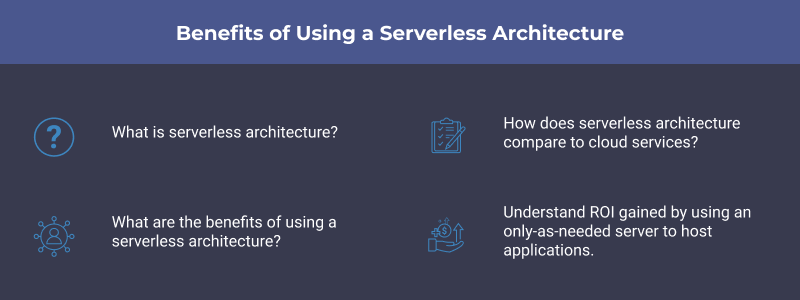The benefits of a serverless architecture
Serverless architecture is a type of cloud computing that enables development teams to get applications to market faster. Serverless means the server infrastructure is fully managed by a provider, so there’s no need to manually track and manage application scale or cloud server configurations.
Serverless architecture provides benefits including reduced operating costs and always-on servers that support web and mobile applications. Servers are created on the fly only when required by the application. Instant availability creates additional scalability when compared to a cloud system.

This guide describes the serverless architecture service, how it differs from the cloud as well as its advantages, risks, and business rewards.
What is serverless architecture?
Serverless architecture is a form of cloud computing where all backend operations involved in running and building an application are managed by a service provider. The provider uses automatically scales server use based on the application’s usage demand. All backend service, database, and cloud server management are handled by the service provider.
Amazon Web Services (AWS) offers a serverless architecture system, as do Microsoft Azure and Google, to name only a few. Most cloud providers offer a serverless architecture option. As an application end user, there’s no distinction between being an application using a cloud system or a serverless architecture. The application functions on either system. The only difference is who is controlling and managing the server system, code deployment, and code releases.
What are the benefits of serverless architecture?
Building applications on a serverless architecture offer several advantages. First, the business costs are significantly reduced by not having to purchase and manage servers. Instead, with a serverless architecture, the system is managed by a service provider like AWS. Although the processing may take place within the AWS cloud infrastructure, processing only takes place when needed.
Application development built on a serverless system scale automatically with usage, regardless of how high or low the usage is at any given time. The impact of sudden, high user loads is reduced as the serverless architecture scales up and down at any level. Serverless architecture allows development teams to focus on UX design and quality code development instead of managing deployments and code within a cloud system.
Additionally, serverless architecture saves time for developers and improves the overall performance of the application for customers. Developers can leverage the service provider and code using a variety of languages as needed. Microservices and APIs are available to help ease the early-stage migration process.
A serverless architecture provides more options for controlling application behavior. For example, developers may use triggers rather than coding separately functioning APIs.
Other benefits of adopting serverless architecture include:
- Improved scalability
- Coding flexibility
- Faster deployments and updates
- No need to purchase or manage backend servers and systems
- Improved developer productivity
- Enables smaller, quicker application release cycles
Disadvantages of using a serverless architecture include:
- Multitenancy systems and security concerns
- Dependency on a third-party service provider for backend services
- Minor application performance impacts when the system starts up after periods of non-use
- Increased difficulty in testing and debugging backend systems
How does serverless architecture compare to cloud services?
Cloud service providers house servers in data centers. Servers are managed and maintained by the cloud service provider. Cloud data storage provides data access from any device connected to the internet. Cloud systems provide managed services in a wide variety of methods and payment options. Businesses on cloud systems are typically responsible for the business-side security of applications and data. Additionally, businesses manage scalability, configuration settings, and processes using an admin self-service portal.
Cloud system offerings are typically infrastructure-as-a-service (IaaS), platform-as-a-service (PaaS), software-as-a-service (SaaS), and testing-as-a-service or tech-as-a-service (TaaS). Essentially, the cloud provider hosts businesses who want them to manage an application, platform, infrastructure, or testing service.
Serverless computing is a type of cloud system computing. Serverless architecture removes all responsibility of server system maintenance, configuration, scalability tracking, and management from the business and puts it on the service provider. Businesses using serverless architecture focus more on rapid software development and the release of mobile and web applications. Developer productivity focuses on coding rather than managing servers and code and release deployments.
Developing applications is easier on a serverless architecture. Application development spends more time on UX design, coding, and testing. The service provider manages code deployments and releases.
Are you ready to migrate to serverless?
Migrating to a different architecture is never easy or inexpensive. Start the process with strategic and financial planning to best understand the risks and workarounds a successful migration requires. One way to simplify the migration process is to use microservice functions during the early stage migration process.
Microservices are used to reduce the amount of coupling between application flow paths. Essentially, developers use a microservice to replace individual server calls within the code. RESTful APIs are frequently used as a method to efficiently process functions within the application only when needed. Microservices are not typically part of a serverless architecture, but are used to support an ongoing migration of existing applications to a serverless system without disrupting application functionality.
Keep in the mind the advantages and risks of moving to a serverless architecture. Improvements in application performance, reduced business costs, and developer productivity need to be weighed over time for a realistic ROI. Serverless architecture provides a host of business-building benefits that enable software application development teams to build applications that are high quality, responsive, and have frequent updates. The future belongs to those who can rapidly develop quality, customer-centric applications that serve customers and build revenue.
Considering migrating to an AWS serverless architecture? Have questions on what you need, or how to proceed? CloudHesive provides support and deep expertise in using the Amazon Web Services cloud and serverless architecture for the best business advantage. As an Amazon Managed Services partner and Amazon Premier Partner, CloudHesive helps businesses take full advantage of all AWS features including serverless architecture implementation and management. See what other customers have to say in case studies available from CloudHesive.



